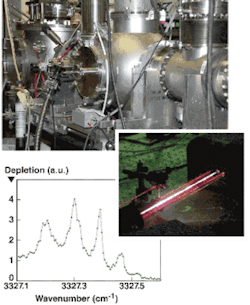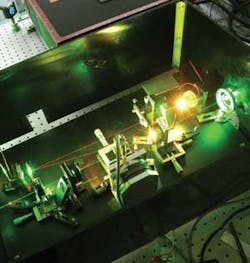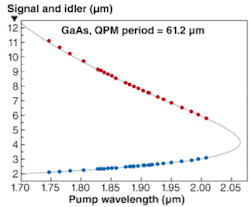ANGUS HENDERSON, RYAN STAFFORD, AND PAUL HOFFMAN
High-power, continuous-wave, tunable laser sources have been key tools in physics and chemistry research laboratories for nearly 40 years. Dye lasers and Ti:sapphire lasers provide ultra-high-resolution output in the visible- to near-IR region with watt-level power and enable a variety of applications in spectroscopy and atomic physics. Continuous-wave (CW) optical parametric oscillators (OPOs)—first demonstrated as long ago as 1968—have long promised to join dye and Ti:sapphire to provide high single-frequency powers not only in the wavelength ranges accessed by these existing sources, but also into the mid-IR, where the field of molecular spectroscopy awaits more capable laser sources.1
With the recent availability of fiber lasers as pump sources for CW OPOs, the first commercial devices with both watt-level power and single-frequency output emerged in the market. More recent advances in fiber-laser technology have enabled a true CW singly resonant oscillator and thus more-practical CW OPOs. And on the horizon are CW OPOs that will offer wide tuning capability to more completely address the visible and near-IR, as well as the long-wave IR region where many common molecules have their fundamental absorption features.
The evolution of CW OPOs
Despite promising early demonstrations, progress in CW OPO technology between 1970 and 1990 slowed because of limitations in available pump sources, nonlinear materials, and in the OPO configurations that could be implemented using them. An ideal pump source for a single-frequency CW OPO possesses single-frequency spectral output, good beam quality, high power (multiple watts), and continuous tunability. Until recently, this combination of attributes was not easy to obtain.
At the same time, nonlinear materials using conventional birefringent phase matching typically possessed modest nonlinear coefficients, meaning that early demonstrations of CW OPOs were performed with unwieldy sources such as argon ion lasers. Commonly the limited nonlinear drive also required that the OPO cavity was resonant at both of the two OPO output wavelengths (known as signal and idler). Although stable operation and tuning of such devices has been demonstrated using cavity servo-locking techniques, doubly resonant oscillators remain sensitive to perturbations and are challenging to tune.2
Quasi-phase-matched materials
The advent of quasi-phase-matched nonlinear materials, particularly periodically poled lithium niobate (PPLN) has transformed CW OPO capabilities. The ability to access the highest available nonlinear coefficient of the nonlinear material has reduced by an order of magnitude the pump-laser power required to reach oscillation threshold, when compared with nonlinear materials using conventional birefringent phase matching. In addition, quasi-phase-matching allows the output wavelength to be engineered, typically through poling of the material with a specific period, rather than relying upon the crystal properties to define the phase-matching conditions and achievable wavelength. As a result, almost any wavelength within the transparency range of the crystal can be generated.
Thanks to these developments, the first commercial CW OPO appeared on the market in 2000. This PPLN-based device used a 1.2 W diode-pumped Nd:YAG laser as its pump source and produced up to 100 mW of single-frequency idler output. Despite the limited pump power, oscillation threshold was achieved by resonating both pump and signal waves in the OPO cavity (a configuration known as a pump-enhanced singly resonant oscillator) using electronic servo-lock of the OPO cavity length.
Fiber-laser pumps
The singly resonant oscillator (SRO) configuration (in which only signal or idler is resonant within the optical cavity) provides the most straightforward operating and tuning characteristics. Lockheed Marting Aculight‘s “Argos” product is pumped by a single-frequency ytterbium fiber laser in a master-oscillator power-amplifier (MOPA) configuration that produces 15 W of ultranarrowband output with perfect beam quality from a compact rack-mount module. The water cooling typically required by comparable diode-pumped crystal lasers is eliminated, as is any susceptibility to optical-component misalignment, making the OPO system as a whole substantially more practical.
The OPO efficiently converts the pump radiation to the signal and idler wavelengths, with multiwatt single-frequency output produced in both wavelength branches (see Fig. 1). The output collimator of the fiber laser is “keyed” so that the pump laser can be routinely swapped between three interchangeable modules to access the complete tuning range between approximately 1.46 to 3.90 μm (with a small approximately 100 nm gap near the degenerate wavelength). The tunability of the fiber oscillator allows up to 60 GHz mode-hop-free tuning of the idler, solely by tuning the pump laser (either with a piezo transducer or by temperature variation). This mode-hop-free tuning capability makes the system attractive for spectroscopic measurements in the 2 to 4 μm idler wavelength region, an important spectral region known for the carbon-hydrogen stretch, or “C-H stretch”—a spectral region where many strong rovibrational transitions occur for hydrocarbon molecules.
Applications
Argos CW OPO systems are already in use in university and government laboratories in the U.S., the U.K., Canada, Germany, and Switzerland. Because the systems are shipped with the pump-laser output fiber plugged into an OPO module, they do not require installation and alignment by an expert user (as would be the case for a dye or Ti:sapphire laser).
Wolfgang Jaeger, professor at the University of Alberta (Edmonton, AB, Canada) is using an Argos for helium nanodroplet research. Superfluid helium nanodroplets provide an ultracold environment to study novel chemical species. The helium droplet instrument measures microwave and infrared (IR) spectra of embedded molecules (see Fig. 2). Jaeger and his coworkers use the high power of the OPO at a wavelength of 3006 nm to measure spectra of cyanoacetylene. “The high power and good frequency stability of the OPO allows for rapid investigation of the doped droplets, which have a number density of approximately only 1010 cm—3,” said Jaeger. “Other high-power IR lasers lack the broad, rapid tunability essential for our application.”The tunability, narrow linewidth, and high power available from a CW OPO in a spectral region that is otherwise challenging to access makes it ideal for a variety of research areas, including laser cooling of atoms, quantum computation, surface science, cavity ring-down spectroscopy, and spectroscopy in supersonic jets of atoms. In addition to these “blue-sky” research areas, the high power and IR wavelengths of the OPO are being used in applications directly connected to real-world problems in industry and the military such as trace-gas sensing via the photoacoustic technique for high-sensitivity detection of pollutants in the atmosphere or in industrial processes. For applications such as missile defense, the ability to tune the operating IR wavelength to an atmospheric “transmission window” (such that power is not lost to absorption by atmospheric components, including water vapor and carbon dioxide) is important.
Into the visible
Commercial CW OPO products currently exist only for the near- to mid-IR regions due to the prevalence of capable pump sources at approximately 1 μm and the maturity of PPLN nonlinear material. However, efforts are ongoing at various organizations around the world to develop devices offering similar performance in other wavelength ranges.
Visible output can be generated in a CW OPO either directly by pumping at a visible wavelength (typically green solid-state lasers), or by frequency converting the output from a green or IR-pumped OPO.
Green-pumped OPOs are attractive for their capability to generate output from the visible to the mid-IR region in a single device (see Fig. 3). However, the available nonlinear materials for green pumping are limited by absorption of visible wavelengths and the resultant thermal lensing. An alternate approach is intracavity frequency mixing of the pump, signal, and idler waves in the OPO cavity. In 1998, sum-frequency generation (SFG) of the pump and the resonant wave was used to generate as much as 2.5 W red output at 629 nm.3Although this demonstration was limited by photorefractive damage to the PPLN material, more recent demonstrations of intracavity conversion of CW OPOs operating in periodically poled stoichiometric lithium tantalate (PPSLT) have shown stable operation with power levels of approximately 0.5 W demonstrated in the blue (see www.laserfocusworld.com/articles/335959) and the red by intracavity second-harmonic generation (SHG) of the resonant wave.4,5Fabien Bretenaker, Cyril Drag, and Thu-Hien My of the Centre National de la Recherche Scientifique (CNRS) in France have developed a green-pumped CW OPO in which intracavity SHG of the IR idler wave produces stable single-frequency red radiation. “The visible CW OPO is a very promising source for high-resolution spectroscopy in, for example, photodetachment microscopy, coherent control of rare-earth ions for quantum memories, or as an all-solid-state source for the trapping of cold sodium atoms. Our measurements have demonstrated it to be inherently much quieter than a dye laser at the same wavelength. This also opens the way to the stabilization of the frequency of such a source to an unrivaled level in this wavelength range,” said Bretenaker and Drag.
The future: long-wave IR
At the other end of the spectral range offered by PPLN, the development of orientation-patterned gallium arsenide (OP-GaAs), pioneered at Stanford University (Palo Alto, CA) and Thales (France), promises to extend the wide tuning capability of OPO technology to more completely address the long-wave IR “fingerprint” region where many common molecules have their fundamental absorption features. The wide transparency (1 to 17 μm) and high nonlinear coefficient of gallium arsenide makes it a promising candidate for wide coverage of this spectral range. Already, pulsed OPOs have been demonstrated in this material, showing wavelength tuning from 2 to 11 μm in a single device (see Fig. 4).6One of the authors of this work, Konstantin Vodopyanov, a professor at Stanford University, notes that several groups are working on further development. “Continued development of the growth techniques and diagnostics for the patterned GaAs structures at Stanford, BAE Systems, Air Force Research Labs, and Thales has resulted in steady improvement of the OP-GaAs properties,” says Vodopyanov. “In particular, thicker samples with shorter patterning period have been grown and attenuation losses below 0.005 cm—1 have been demonstrated. This dramatic progress makes it likely that CW oscillation can be attained in the near future.”
REFERENCES
- R.G. Smith et al., Applied Physics Lett. 12, 308 (1968).
- A.J. Henderson et al., Optics Lett. 25, 1264 (2000).
- W.R. Bosenberg et al., Optics Lett. 23, 207 (1998).
- G.K. Samanta and M. Ebrahim-Zadeh, Optics Lett. 33, 1228-1230 (2008).
- T. My, C. Drag, and F. Bretenaker, Optics Lett. 33, 1455 (2008).
- K.L. Vodopyanov et al., Optics Lett. 29, 1912 (2004).
ANGUS HENDERSON is principal scientist and RYAN STAFFORD and PAUL HOFFMAN are development engineers at Lockheed Martin Aculight, 22121 20th Ave. SE, Bothell, WA 98021; e-mail: [email protected]; www.aculight.com.



